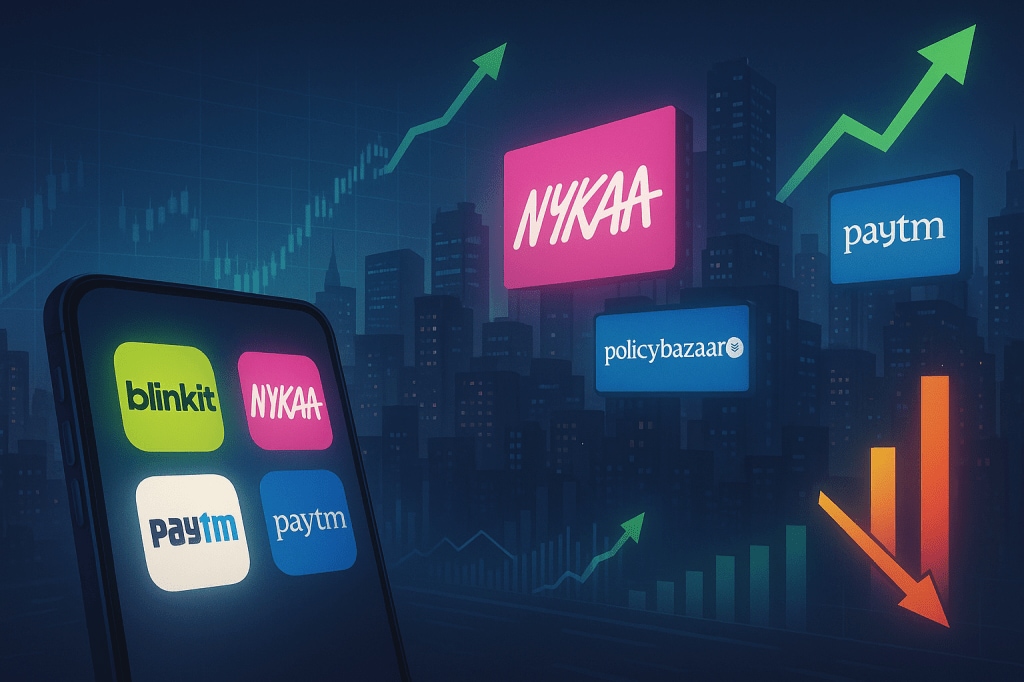India’s internet economy is entering a phase of separation not slowdown says JM Financial. The domestic brokerage house noted that quick commerce players are sprinting ahead and e-commerce platforms are consolidating gains. Meanwhile, fintech leaders are seeing some cool off after years of expansion. The mood across the space has shifted from raw growth to managed ambition.
Here is a company-wise breakdown based on the analysis of JM Financial.
JM Financial on quick commerce: Blinkit, Zepto, Swiggy Instamart
Blinkit
Blinkit’s momentum remained the sharpest in India’s internet space. Backed by Zomato, JM Financial expects Blinkit’s net order value (NOV) to grow 28% sequentially and 139% year-on-year in Q2FY26, with an adjusted EBITDA margin of around –0.8%, a sharp improvement from double-digit losses a year earlier. The difference is not cosmetic; it signals operational leverage finally working through scale and density. Blinkit’s contribution margin improved to 4.4% from 3.9% in the previous quarter.
According to JM Financial, Blinkit is already the market leader with nearly 40% share, outpacing Swiggy Instamart and Zepto combined in several metro clusters. Its expansion pace remains disciplined, targetting top 30–40 cities where per-order economics justify the model.
Zepto
Zepto’s narrative is that of acceleration. Co-founder Aadit Palicha told investors earlier this year that growth of 150% over 12 months is achievable. The platform’s market share rose to nearly 28% in 2024 from 15% in 2022, as per Statista data cited in the JM Financial report. The brokerage pointed out that Zepto’s burn rate per delivery has narrowed but remains significant, with breakeven in sight only in the densest urban pockets.
The brokerage’s analysis suggests Zepto will lean on technology-led optimisation route planning and in-store automation rather than aggressive price discounts, which could keep gross margins stable even as it expands its network.
Swiggy Instamart
Swiggy Instamart has taken the hardest hit in terms of market share. From 52% in March 2022, its share fell to 32% by early 2024, and revenue growth has slowed relative to peers. JM Financial attributed the decline to slower network scaling and a pivot towards profitability within Swiggy’s consolidated operations.
Overall, JM Financial estimates India’s quick commerce industry could reach $5.5 billion (Rs 45,760 crore) by 2025, with contribution to the online grocery market rising from 10% to 45% in the next few years. That trajectory suggests the sector is no longer a side-show it’s becoming the frontline of consumption convenience.
JM Financial on E-commerce: Nykaa, FirstCry, Delhivery
Nykaa
As per JM Financial’s Q2FY26 update, Nykaa reported GMV of Rs 4,673 crore, showing growth in the low thirties year-on-year, marking an acceleration from the previous quarter. The brokerage triangulated core beauty and personal care (BPC) GMV growth at around 25% YoY, assuming strong performance across eB2B and Nykaa Man, which together grew about 44% YoY.
JM Financial noted that BPC margins remain robust, with contribution from owned brands helping offset incremental marketing spends. The fashion vertical, which was once a drag on profitability, has gained traction through better curation, private-label strength, and improved discovery.
The brokerage house expects EBITDA margin to improve to around 7.1%, aided by advertising efficiency and operating leverage in both verticals.
FirstCry
FirstCry, the baby and kids product retailer, continued to scale cautiously post its IPO filing. JM Financial’s analysis showed solid GMV growth driven by online channels, complemented by steady store additions. FY25 saw moderate topline improvement with a focus on operational discipline. While the company’s exact revenue is not disclosed, the report estimated steady growth supported by a widening private-label mix.
JM Financial noted that FirstCry’s competitive advantage lies in brand partnerships. The hybrid model, though cost-intensive, provides resilience in a volatile e-commerce landscape.
Delhivery
Delhivery, the logistics backbone of India’s digital economy, JM Financial stated, is stabilising. The brokerage’s Q2FY26 estimates peg revenue at around Rs 2,697 crore, up 23.2% year-on-year. The company’s express parcel volumes grew nearly 20%, indicating demand resilience even as overall e-commerce shipment growth steadies.
JM Financial’s model assumes continued margin improvement, driven by automation, yield management, and network optimisation. It remained cautiously optimistic, rating the company an “ADD,” citing scale advantages and stronger cost control.
JM Financial on Fintech: Paytm, Policybazaar (PB Fintech)
Paytm
Paytm’s narrative shifted from revenue growth to profitability maintenance. In Q2FY26, Paytm’s revenue stood at around Rs 2,050 crore, up 23.5% year-on-year. The slowdown visible earlier in the year has given way to cautious stability as the company navigates the RBI’s restrictions on its Payments Bank operations, which curtailed wallet-based and deposit-linked flows.
Payment volumes remain strong, but the lending segment the company’s new profit engine has cooled under tighter risk scrutiny from partners. The report maintained that while Paytm’s merchant ecosystem remains robust, customer acquisition costs have increased. The brokerage expects gradual normalisation once regulatory clarity returns.
Policybazaar (PB Fintech)
PB Fintech, which runs Policybazaar and Paisabazaar, continued to execute steadily, though investor patience for profitability remains thin. JM Financial’s Q2FY26 estimates show revenue at around Rs 1,566 crore, up 34% year-on-year.
JM Financial noted that life insurance growth has moderated, while health and motor categories continue to drive new premium volumes. JM Financial retained its constructive view, calling PB Fintech structurally sound but vulnerable to cyclical moderation in insurance demand.
What does this mean for investors?
Across segments, the divergence is clear. Quick commerce is expanding furiously, but the burn remains. E-commerce is rationalising, fintech is recalibrating. The brokerage’s model portfolio tilts toward companies with visible operating leverage and improving cash flows Blinkit within Zomato, Nykaa, and PB Fintech among them.
In short, India’s internet sector is not cooling it’s differentiating. Speed alone won’t sustain the next phase of growth. Efficiency, liquidity discipline, and local economics will. And for once, every company knows it, as per the report.


